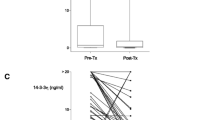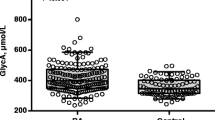Abstract
We have shown that serum levels of reactive oxygen metabolites (ROM) were associated with C-reactive protein (CRP) and disease activity score based on the examination of 28 joints (DAS28) in patients with rheumatoid arthritis (RA); however, their clinical significance as biomarkers has not been elucidated. Forty-eight biologic agent (BA)-naïve RA patients were included in this study. Associations between serum levels of ROM, CRP, matrix metalloproteinase-3 (MMP-3), DAS28-erythrocyte sedimentation rate (ESR), and Health Assessment Questionnaire (HAQ) at 12 weeks of treatment and DAS28 (ESR) remission at 52 weeks (52-week remission) were investigated. The ROM serum level at baseline in the remission group (n = 34) was 527 ± 132 Carratelli units (U.Carr) (normal range <300), decreased to 335 ± 79.1 at 4 weeks, and remained low thereafter. In the non-remission group (n = 14), the ROM serum level at baseline was 592 ± 113 U.Carr, decreased to 450 ± 152 at 4 weeks, but gradually increased thereafter. Among significantly different factors at 12 weeks between the remission and non-remission groups, ROM and DAS28 (ESR) were identified as predictors of 52-week remission (p = 0.045, odds ratio 0.985, 95% confidence interval 0.97–1.000 for ROM). The cutoff value of ROM was determined to be 381.5 U.Carr (sensitivity 0.833, specificity 0.871). These results show that serum ROM levels can predict remission with high accuracy and could be a useful biomarker for achieving remission in the current treat-to-target strategy for RA.



Similar content being viewed by others
References
Pap T, Muller-Ladner U, Gay RE et al (2009) Fibroblast biology: role of synovial fibroblasts in the pathogenesis of rheumatoid arthritis. Arthritis Res 2:361–367
Mapp PI, Grootveld MC, Blake DR (1995) Hypoxia, oxidative stress, and rheumatoid arthritis. Br Med Bull 51:419–436
Hitchon CA, El-Gabalawy H (2004) Oxidation in rheumatoid arthritis. Arthritis Res Ther 6:265–278
Halliwell B (1995) Oxygen radicals, nitric oxide, and human inflammatory joint disease. Ann Rheum Dis 54:505–510
Tak PP, Zvaifler NJ, Grenn DR et al (2000) Rheumatoid arthritis and p53: how oxidative stress might alter the course of inflammatory diseases. Immunol Today 21:78–82
Biemond P, Swaak AJ, Koster JF (1984) Protective factors against oxygen free radicals and hydrogen peroxide in rheumatoid arthritis synovial fluid. Arthritis Rheum 27:760–765
Carratelli M, Porcaro L, Ruscica M et al (2001) Reactive oxygen metabolites and prooxidant status in children with Down’s syndrome. Int J Clin Pharm Res 21:79–84
Trotti R, Carratelli M, Barbieri M et al (2001) Oxidative stress and a thrombophilic condition in alcoholics without severe liver disease. Haematologica 86:85–91
Nakajima A, Aoki Y, Shibata Y et al (2014) Identification of clinical parameters associated with serum oxidative stress in patients with rheumatoid arthritis. Mod Rheumatol 6:926–930
Quintana-Duque MA, Rondon-Herrera F, Mantilla RD et al (2016) Predictors of remission, erosive disease and radiographic progression in a Colombian cohort of early onset rheumatoid arthritis: a 3-year follow-up study. Clin Rheumatol 6:1463–1473
Hoshi D, Nakajima A, Shidara K et al (2013) Disability is the major negative predictor for achievement of Boolean-based remission in patients with rheumatoid arthritis treated with tocilizumab. Mod Rheumatol 23:1205–1210
Shiozawa K, Yamane T, Murata M et al (2016) MMP-3 as a predictor for structural remission in RA patients treated with MTX monotherapy. Arthritis Res Ther. doi:10.1186/s13075-016-0948-7
Shen J, Shang Q, Wong CK et al (2015) IL-33 and soluble ST2 levels as novel predictors for remission and progression of carotid plaque in early rheumatoid arthritis: a prospective study. Semin Arthritis Rheum 45:18–27
Ammitzbøll CG, Thiel S, Jensenius JC et al (2013) M-ficolin levels reflect disease activity and predict remission in early rheumatoid arthritis. Arthritis Rheum 65:3045–3050
Pomirleanu C, Ancuta C, Miu S et al (2013) A predictive model for remission and low disease activity in patients with established rheumatoid arthritis receiving TNF blockers. Clin Rheumatol 32:665–670
Mateen S, Moin S, Khan AQ et al (2016) Increased reactive oxygen species formation and oxidative stress in rheumatoid arthritis. PLoS One 11:e0152925
Khojah HM, Ahmed S, Abdel-Rahman MS et al (2016) Reactive oxygen and nitrogen species in patients with rheumatoid arthritis as potential biomarkers for disease activity and the role of antioxidants. Free Radic Biol Med 97:285–291
Del Rincon I, Williams K, Stern MP et al (2001) High incidence of cardiovascular events in a rheumatoid arthritis cohort not explained by traditional cardiac risk factors. Arthritis Rheum 44:2737–2745
Van Doornum S, McColl G, Wicks IP (2002) Accelerated atherosclerosis: an extraarticular feature of rheumatoid arthritis? Arthritis Rheum 46:862–873
Jacobsson LT, Turesson C, Hanson RL et al (2001) Joint swelling as a predictor of death from cardiovascular disease in a population study of Pima Indians. Arthritis Rheum 44:1170–1176
Del Porto F, Lagana B, Lai S et al (2007) Response to anti-tumour necrosis factor alpha blockade is associated with reduction of carotid intima-media thickness in patients with active rheumatoid arthritis. Rheumatology 46:1111–1115
Faienza MF, Francavilla R, Goffredo R et al (2012) Oxidative stress in obesity and metabolic syndrome in children and adolescents. Horm Res Paediatr 78:158–164
Coaccioli S, Standoli ML, Biondi R et al (2010) Assessment of the oxidative stress markers in patients with chronic renal insufficiency undergoing dialysis treatment. Clin Ter 161:441–444
Koutsokera A, Papaioannou AI, Malli F et al (2009) Systemic oxidative stress in patients with pulmonary sarcoidosis. Pulm Pharmacol Ther 22:603–607
Suzuki S, Matsukura S, Takeuchi H et al (2008) Increase in reactive oxygen metabolite level in acute exacerbations of asthma. Int Arch Allergy Immunol 146(Suppl 1):67–72
Kotani K, Koibuchi H, Miyamoto M et al (2010) Relationship between reactive oxygen metabolites and carotid intima-media thickness in subjects with hypercholesterolemia. Med Princ Pract 19:496–498
Yamanaka G, Kawashima H, Suganami Y et al (2006) Diagnostic and predictive value of CSF d-ROM level in influenza virus-associated encephalopathy. J Neurol Sci 243:71–75
Acknowledgements
The authors are grateful to Mr. Keiichiro Terayama for his assistance with statistical analyses. This work was supported in part by Grant-in-Aid from the Ministry of Education, Science, Technology, Sports and Culture of Japan (no. 23592233 to A.N.) and the Research Promotion Grant from Toho University Graduate School of Medicine (no. 15-03 to A.N.).
Author information
Authors and Affiliations
Corresponding author
Ethics declarations
Approval for the study was received from the Institutional Review Board at Toho University, and all patients gave their consent before their inclusion in this study. All activities were performed in accordance with the ethical standards set forth in the Declaration of Helsinki.
Disclosures
None.
Rights and permissions
About this article
Cite this article
Nakajima, A., Aoki, Y., Sonobe, M. et al. Serum level of reactive oxygen metabolites (ROM) at 12 weeks of treatment with biologic agents for rheumatoid arthritis is a novel predictor for 52-week remission. Clin Rheumatol 36, 309–315 (2017). https://doi.org/10.1007/s10067-016-3479-3
Received:
Revised:
Accepted:
Published:
Issue Date:
DOI: https://doi.org/10.1007/s10067-016-3479-3




